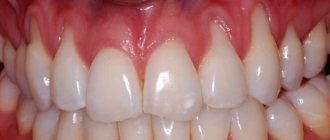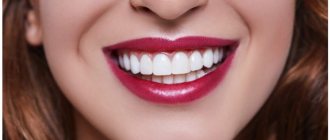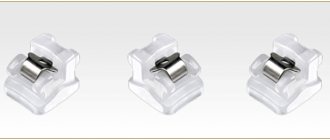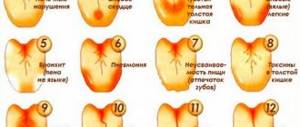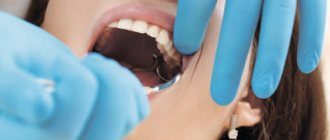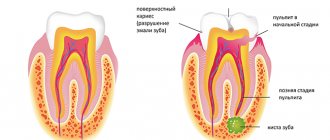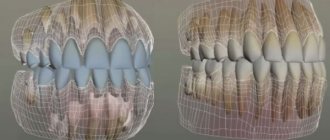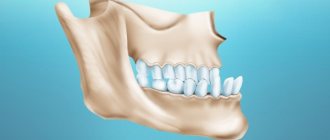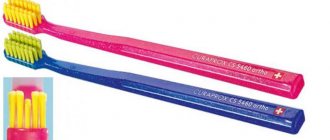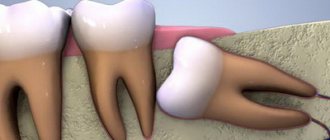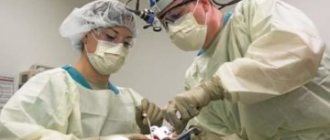Impacted teeth are abnormally located teeth that cannot erupt into the oral cavity on their own and remain “sit” in the jawbone for years. To designate such an anomaly of the dental system, dentists use the term “retention” (translated from Latin as “retention”, “restraint”). Many dental patients have had to deal with problems caused by impacted wisdom teeth. Unfortunately, not only the “eights” are susceptible to retention, but also the canines, as well as the lateral and central incisors. Impacted teeth can be called a time bomb, as they can create a lot of trouble for their owner.
What is an impacted tooth?
Retention is an abnormality in tooth eruption, in which the tooth erupts partially or remains completely in the tissues of the jaw.
An impacted tooth is a tooth that has failed to erupt and “sleeps” in the gum or even in the jaw bone. There are cases when only part of the tooth crown erupts and is visible, and the rest of the tooth is covered by the gum - such teeth are called semi-impacted.
Most often, impacted canines and wisdom teeth are found - the notorious eights, but there are cases of impaction of the central and lateral incisors, and the first - a little more often.
How to prevent the development of a defect
If the wedge-shaped defect is not treated, the disease will develop and the tooth will collapse. But treatment methods have their drawbacks, they are not durable enough and do not guarantee that the pathology will not invade neighboring teeth.
To avoid an unpleasant disease, you need to take into account risk factors and take care of your own health and dental condition.
The most important preventive measures:
- brush your teeth correctly and choose oral hygiene products;
- undergo regular examinations in good dental clinics;
- trust dental manipulations only to a trusted orthodontist;
- correct the bite in time;
- promptly treat periodontal diseases;
- exclude soda and sour juices. Eat fresh foods containing enough vitamins and minerals;
- promptly identify and treat diseases of the gastrointestinal tract, nervous and endocrine systems.
What are the types of tooth impaction?
There are two types of retention - partial, in which part of the tooth is visible from the gums, and complete - in which the tooth is completely located under the gum tissue and/or jaw bone.
Such teeth can also be positioned differently, both being in “their” place in the dentition and occupying an incorrect position outside the dentition.
- Vertical
- Horizontally.
- At an angle to the jaw
If a tooth does not erupt in the right place beyond the border of the dentition, they speak of tooth dystopia.
There are even reverse retentions, when the tooth lies “upside down,” that is, upside down with its roots.
There may be only one impacted tooth in the dentition, or two impacted teeth may be located symmetrically. This problem concerns both milk and permanent teeth.
The essence of the technique
When pulling a tooth, it can not only be moved vertically, but also tilted in the desired direction.
This is possible due to a number of anatomical features of the structure of the root part of the organ, as well as due to the use of a certain force. Experts strive for the appearance of so-called pressure zones, which ensure the occurrence of histological changes.
It is necessary to understand that this procedure cannot be carried out in several sessions. As practice shows, it takes several months to finally restore the normal physiological position.
Although there are exceptions for some patients. One of the main factors determining the speed of this process is the age of the patient.
What complications do impacted teeth cause and why do they need to be “extracted”?
It is difficult for the patient to immediately understand what danger “hidden” teeth can pose, but it is really serious.
Semi-retinated teeth cause inflammation of the “hood” with which they are covered and adjacent tissues, and this provokes purulent inflammation.
Fully impacted teeth that lie in the jaw can behave like a foreign body; they put pressure on neighboring teeth, causing their displacement and a number of other problems.
In this case, the patient experiences pain and fever in case of inflammation, a feeling of pressure and discomfort in the jaw, neuralgia or numbness of part of the face.
If we list the diseases that can result from impacted teeth, it will become clear that this is a real “time bomb” that can detonate at any moment.
What diseases can be caused by an impacted tooth:
- periodontal cyst,
- caries of neighboring teeth and their roots,
- pulpitis,
- pericoronitis,
- periostitis,
- periodontitis,
- purulent lymphadenitis,
- inflammation of the trigeminal nerve,
- odontogenic sinusitis,
- abscess,
- phlegmon,
- resorption (resorption) of the roots of adjacent teeth,
- bad habits: mouth breathing, infantile swallowing, inserting the tongue into a dental defect,
- problems with biting food,
- malocclusion, displacement of interdental contacts, crowding of teeth.
Why wedges form on teeth and what to do about it
The defect can develop on both the upper and lower jaw, on one or more teeth. Most often, canines and premolars are affected - namely, they experience a large chewing load. The disease develops gradually and unnoticed. Over time, the defect deepens into the dentin, and the person feels pain. If the problem continues to be ignored, the base of the tooth becomes so thin that it can break.
A wedge-shaped defect appears in people of different ages, including teenagers. However, the older the person, the greater the risk of developing pathology.
The moment of appearance of the wedge-shaped defect cannot be tracked independently. But if you undergo regular examinations with a dentist, treatment will begin on time and will be completed with minimal time and money.
At first glance, a wedge-shaped defect can be confused with cervical caries. The affected teeth are marked with triangular-shaped spots and depressions, up to 4 mm in depth in the acute stage of development.
As for where wedges on teeth come from, there are three generally accepted theories:
- Chemical. The culprit is aggressive acids from food, drinks and resulting from an imbalance in the acid balance of the oral cavity.
- Mechanical. The defect is caused by an external load.
- Physico-mechanical. Pathology develops in response to improper chewing load.
How are impacted teeth diagnosed?
Impacted teeth are often “found” by accident during an X-ray diagnosis for another dental reason. If a patient asks about orthodontic treatment and is missing some teeth, or has symptoms that may be caused precisely by the presence of hidden impacted teeth, then a special diagnosis is carried out.
The problem of impacted teeth is solved by two specialized dentists - an orthodontist and a surgeon, so the patient will have to undergo diagnostics by an orthodontist and diagnostics by a surgeon. Most of the diagnostic procedures will be general, and the key is x-ray diagnostics, and it is preferable to do CT - computed tomography (3D diagnostics). Unlike an orthopantomogram (OPTG), it shows the spatial location of the impacted tooth in the jaw and relative to other teeth, which is very important for the surgical stage of traction - exposing its crown, because allows the surgeon to choose the optimal “approach”.
Expected effect
The tooth is pulled out using a specially installed system. Although the procedure occurs without any pain, you should prepare in advance for the fact that you will have to spend a lot of time.
As practice shows, it takes an average of 3-4 months to restore milk units, while for older patients it can last up to nine months.
When determining the amount of time required for treatment, the complexity of the individual case and the current condition of the oral cavity as a whole are taken into account. With the help of a chain, the doctor completely extends the element with every millimeter.
The end result is complete extension of the tooth. The best option is when a third party is shown the results of treatment without telling him about the fact of the procedure, and at the same time he does not understand what the differences are between a normal and an extraordinary situation.
In other words, the result is of high quality only when the tooth is fully extended to return to its normal physiological position.
The operating time of the elongated element may also vary depending on the condition it was in at the time of treatment.
It is extremely important to prevent the development of any diseases, as well as to cope with existing pathologies. Otherwise, the patient risks encountering complications in the form of infection in the treated area and nearby units.
In terms of time of use, the treated molar will be no different from the rest. The main thing is to adhere to the rules of personal hygiene and constantly monitor the appearance of signs of the disease.
But this will be prevented by regular visits to the dentist. One way or another, you will still have to regularly go to the dental office, because doctors need to fully control the recovery process.
What to do if an impacted tooth is found?
There are 3 solutions to the problem of an impacted tooth:
- Orthodontic traction and placement in the dentition. This is often done with impacted teeth that are located in the smile zone - canines and incisors, provided that there is a place for them in the dentition and the tooth itself is healthy.
- Removal is a common fate for impacted eights, especially if the patient is undergoing orthodontic treatment. Very often, wisdom teeth erupt partially – this provokes inflammation and complications. Even a completely impacted (“hidden”) tooth serves as a potential source of caries, tooth displacement, and instability of orthodontic treatment. There are many reasons - there is only one verdict: it is better to delete it. Other indications for the removal of different types of impacted teeth are cysts, signs of inflammation, lack of space in the dentition, destruction of the neck of the tooth, caries.
- Preservation and surveillance. It is justified when the patient has no problems with the place in the dentition or bite, orthodontic treatment is not required, the tooth does not provoke complications and its absence does not spoil the aesthetics of the smile. Such teeth are observed; in case of the slightest problem, they are recommended to be removed.
Advantages and disadvantages of technology
When performing orthodontic tooth traction, it is possible to prevent preparations that are located in the vicinity. The need to create removable dentures/bridges is also avoided.
This is of great importance, especially when adjacent units are covered with a high-quality metal-ceramic crown, which could be removed for subsequent bridge production. The client does not have to pay extra money.
It is also worth noting that the original contour of the nearby soft tissue is completely preserved, which is very important in terms of aesthetics.
Therefore, the main candidates for this procedure are dental office visitors who do not want to completely remove the root and replace it with an implant.
The disadvantage of the technique is that the gum, the area of which is located in the impacted tooth, begins its recession.
If the periodontal junction is damaged when the crown is exposed, the root that needs to be moved will have to be significantly exposed. This, in turn, is considered a blunder.
How to pull out and place an impacted tooth in the dentition?
In some cases, if the root of an impacted tooth has not yet formed and there is an obstacle to its eruption, then removing such an obstacle is enough for the tooth to come out of the gums and take its place in the dentition. If the tooth root is already formed, this method will not help.
To “get” and move a fully formed impacted tooth into the dentition, treatment is carried out in 3 stages. Here we present the “classical” scheme, because in individual cases there may be deviations from this scheme.
- Preparatory orthodontic stage - you need to prepare a place in the dentition to which the orthodontist will move the extracted tooth. To do this, a braces system is installed, which aligns the teeth in the dentition and frees up the necessary space.
- The surgical stage is the image of the crown of an impacted tooth, on which a bracket or button is installed to transmit force from an arch or elastic element.
- The main orthodontic stage, during which the impacted tooth is pulled out and placed in its “rightful” place in the dentition.
Indications and contraindications
Indications include the following:
- genetic features of development;
- early process of changing milk units;
- the course of vitamin deficiency;
- unnatural jaw development;
- the presence of somatic weakness;
- carrying out prosthetics or removal of problem units without following the established schedule.
The procedure is not carried out if there is no free space to move the element of the jaw row, there are no neighbors near the damaged unit, or when the intracanal pin is difficult to install.
Find out reviews from patients after orthognathic surgery about the complexity and pain of the procedure.
Come here to find out if you can get braces if you have crowns.
At this address https://orto-info.ru/sistemyi-vyiravnivaniya-zubov/breketyi/kak-mozhno-tselovatsya-otkrovenno-o-sokrovennom.html we will tell you how to kiss with braces.
How is surgery performed to expose the crown of an impacted tooth?
- As a preliminary stage, preparation for the operation is carried out. The patient undergoes professional hygiene and sanitation to reduce the amount of infection in the oral cavity and speed up postoperative healing.
- The operation to expose an impacted tooth is performed under local infiltration anesthesia and is considered a fairly serious surgical intervention.
The operation to expose the crown of an impacted tooth and install an orthodontic element on it can be carried out according to 2 schemes:
I Delayed bracket installation.
- The mucous membrane in the projection of the crown of the impacted tooth is excised, the entire crown of the tooth is exposed, and a special tampon is installed in the wound.
- After 2-3 days, a button or bracket is installed on the crown of the exposed tooth, which is tied to the orthodontic arch and traction begins.
II Bracket installation during surgery
- The dentist-surgeon peels off a small mucoperiosteal flap and exposes part of the crown of the impacted tooth, onto which the locking element is immediately fixed.
- The bracket is tied to an orthodontic arch or additional devices.
- After installing the orthodontic element, the flap of tissue is placed in place and the wound is sutured.
The disadvantage of this method is that in this case, repeated surgical intervention is possible if the bracket on the tooth comes off.
After surgery, the patient is prescribed antibiotics and antiseptic rinses, if necessary, to speed up healing. Light, non-traumatic food is recommended.
Treatment
When treating a wedge-shaped tooth defect, the doctor first restores its integrity, then prevents its further destruction. If necessary, dentists of narrow specializations are involved in the treatment of a wedge-shaped defect: therapists, orthodontists, orthopedists.
The following will help restore the condition of the tooth:
- Installation of seals. The doctor removes the altered tissues in the cervical area, and installs filling material in their place. When restoring medium and complex defects, the doctor uses a light-curing fluid composite and compomer materials. They are quite elastic and can partially compensate for the load on the teeth. The best fillings are installed using the sandwich technique: the bottom layer is made of dental cement, the top layer is made of composite materials. For better aesthetics, your doctor may suggest installing ceramic veneers.
- Fluoridation and remineralization. The procedures restore the mineral content in the enamel, this heals the tooth and slows down the process of destruction;
- Prosthetics. If the tooth is severely damaged and there is a risk of fracture at the base of the crown, the doctor will be forced to install a denture. Usually this is permanent prosthetics made of metal-ceramics or using ceramic crowns.
If the wedge-shaped defect has just begun to develop, the following will help slow down the process:
- Remineralizing therapy. Applications with calcium and sodium preparations are applied to the affected part, and the patient is recommended to take a course of vitamin-containing complexes. Remineralization courses must be repeated regularly and they only help at the initial stage of the disease;
- Fluoridation. Effective in cases of deep damage to the enamel, applications with fluoride preparations seal the tubules of the tooth tissue and reduce its sensitivity;
- Laser therapy. Reduces tooth sensitivity and inhibits the development of the disease. Laser treatment is recommended for pregnant and lactating women and patients with allergies.
For home care, the doctor will recommend pastes and gels enriched with a special mineral composition.
Is it possible to install braces without removing them?
Correcting a bite with a braces system comes down to moving the teeth in the right direction. If staples are installed without removing interfering elements, then orthopedic treatment will not bring the desired effect. For some types of pathology, structural features of the dental system and in childhood, extraction is not required.
An alternative to surgery is separation. It involves removing a layer of enamel from the side surfaces of the crowns. This way the required free space is achieved. The procedure is minimally invasive, does not require a recovery period, and does not cause pain or discomfort. The advisability of using this method should be discussed with your doctor.
Cost of removal when installing braces
The price of the procedure consists of several indicators: the complexity of the surgical procedures, the duration of the operation, the number of elements removed, the type of anesthesia, and the cost of drugs. For example, extracting an incisor will cost less than a premolar and at least half as much as a figure eight. General anesthesia also increases the price of the service.
In our dental clinic, you can remove several teeth at once under sedation or anesthesia. This is an absolutely safe and painless treatment. We always strive to preserve the integrity of the dentition. We have dentists of various specializations who, in difficult cases, will hold a consultation to make the right decision. The cost of treatment and removal is discussed with the patient before the procedures begin.
Briefly about braces
They are a system of individual locks and wires that connect them into a single arc. The clasps are fixed with glue on each dental unit. Then a wire is inserted into the grooves, which, in an effort to straighten, moves the teeth in the desired direction.
The brace system evenly distributes the load, eliminates pain when chewing food, reduces the risk of developing caries, diseases of the upper respiratory tract, oral cavity, and eliminates injuries to the cheeks and tongue from protruding elements.
The design does not violate the integrity of tissues, which is very important for preserving the beauty and health of teeth for many years.
